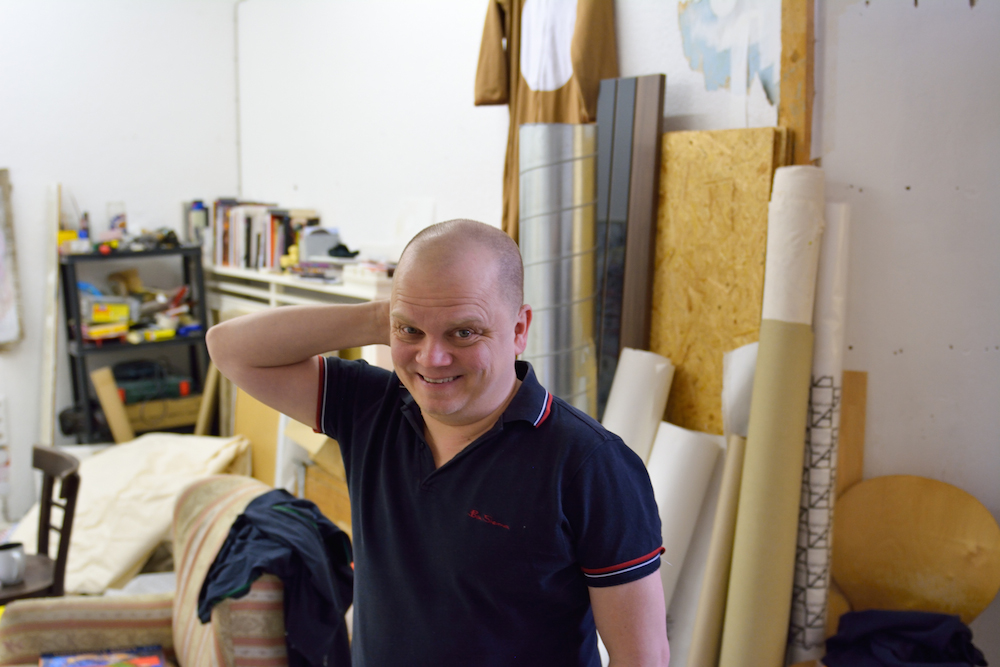
Janne Räisänen’s fourth solo exhibition at Helsinki Contemporary presents a new body of work in which the private and public, the low and the high, collide joyfully on the canvas through uninhibited brushwork and exuberant storytelling. Constructivism Begins at Home marks the Berlin-based artist’s first solo show in Finland in more than four years.
The works on view blend drawing and painting in a raw, distinctive manner, merging techniques from graphite to oil paint. Räisänen’s process – driven by experimentation, chance, and constant trial and error – reveals itself in the layered, restless surfaces of his paintings. He is known for depicting life with humour and wild associative leaps, sometimes veering cheerfully toward the outright bizarre. His miniature epics radiate warm-hearted absurdity, taking a playful dig at both the quirks of contemporary life and the artist himself.
Räisänen approaches the world through a camp sensibility, unveiling unexpected and often hilarious perspectives through irony, hyperbole, parody, and free-form association. His paintings are veritable surprise parties of visual and linguistic play. The tongue-in-cheek, pun-laden titles – some of them downright baffling – form an essential part of his process. They are less explanations than invitations for the viewer’s imagination to leap into the fray.
The title Constructivism Begins at Home first emerged while the artist was painting and listening to The Smiths’ Barbarism Begins at Home. Through a chain of wordplay, “barbarism” gradually morphed into “constructivism.” Despite the reference, Räisänen’s art shares little with the austere formalism of constructivism from a century ago – unless of course he is gently poking fun at any canonical strictness. Yet, his multi-layered works do echo constructivist learning theory: the idea that people build understanding by reshaping new information through their own experience. Räisänen’s paintings are indeed playful constructs, in which film, historical figures, pop music, celebrities, art history, and “real life” swirl together in an irreverent medley.
Inquiries: info@helsinkicontemporary.com
Opening reception on Thursday, January 8 from 5 to 7 p.m.
Janne Räisäsen neljäs Helsinki Contemporarylla nähtävä yksityisnäyttely esittelee taidemaalarin uusia teoksia, joissa yksityinen ja julkinen sekä matala ja korkea kulttuuri suodattuvat kankaalle vallattoman maalauksen ja tarinankerronnan kautta. Constructivism Begins at Home on Berliinissä asuvan ja työskentelevän Räisäsen ensimmäinen yksityisnäyttely Suomessa yli neljään vuoteen.
Näyttelyn teoksissa yhdistellään rouhealla ja persoonallisella tavalla piirustusta ja maalausta sekä eri tekniikoita grafiitista öljyväreihin. Räisänen työskentelee kokeilujen, sattumien, onnistumisten ja epäonnistumisten prosessin kautta, mikä näkyy teosten kerroksellisuudessa. Räisänen tunnetaan teoksista, joissa elämää kuvataan villien mielleyhtymien kautta humoristisesti ja – suoraan sanoen – omituisella tavalla. Teosten pienet suuret tarinat ovat täynnä lämminhenkistä naurua, joka kohdistuu niin ympäröivään maailmanmenoon kuin taiteilijaan itseensä.
Taiteilijana Räisänen tarkastelee maailmaa camp-katseen kautta, joka paljastaa maailmasta uusia hillittömiä puolia ironian, liioittelun, parodian ja estottoman yhdistelyn kautta. Räisäsen teokset ovat kuin visuaalisten ja kielellisten assosiaatioiden yllätysjuhlat. Pilke silmäkulmassa annetut kielellä leikittelevät ja joskus hämmentävätkin nimet ovat tärkeä osa taiteilijan prosessia. Ne eivät toimi selkeinä selityksinä teoksille, vaan ennemmin sysäävät katsojan mielikuvituksen liikkeelle.
Tämän näyttelyn nimi syntyi, kun maalatessaan Räisänen alkoi ajatella The Smithsin kappaletta Barbarism Begins at Home. Jossain kohtaa barbarismin tilalle tuli sanaleikin kautta konstruktivismi. Räisäsen teoksissa on vaikea nähdä yhteyksiä sadan vuoden takaisen konstruktivistisen taiteen ankaraan abstraktioon – hänen taiteessaan on harvoin ankaruutta, ellei kyse ole sitten tiukkapipoisuudelle virnuilusta. Monikerroksiset teokset voivat kuitenkin tuoda mieleen konstruktivistisen oppimisteorian ajatuksen siitä, miten ihminen ymmärtää maailmaa aina muokkaamalla tietoa ja sovittamalla sitä omiin kokemuksiin. Räisäsen teokset ovatkin tällaisia vallattomia rakennelmia, joissa elokuvat, historialliset henkilöt, pop-musiikki, julkkikset, taidehistoria ja niin sanottu oikea elämä sekoittuvat iloisesti.
Tiedustelut: info@helsinkicontemporary.com
Näyttelyn avajaiset torstaina 8.1. klo 17-19

Share this exhibition